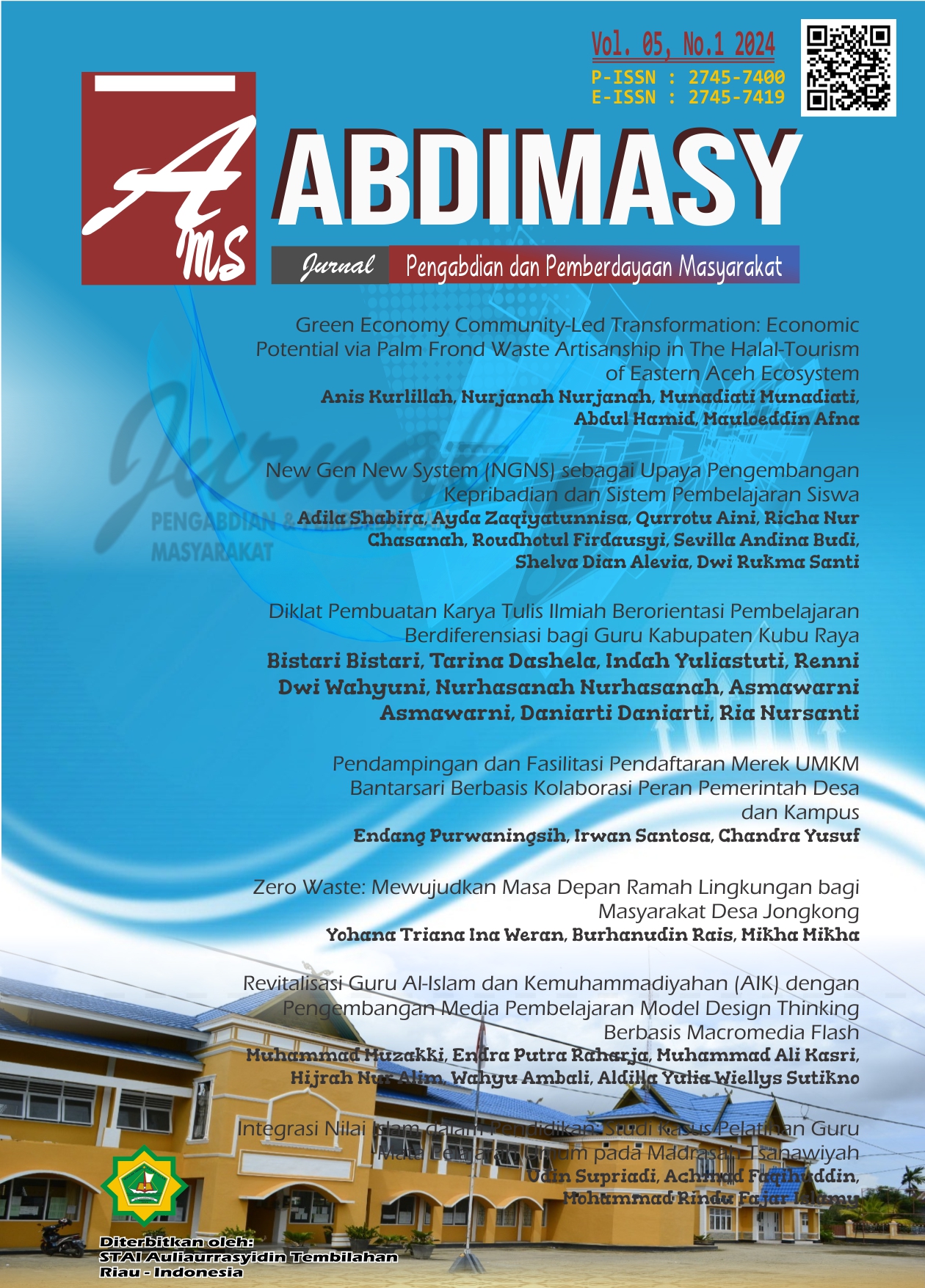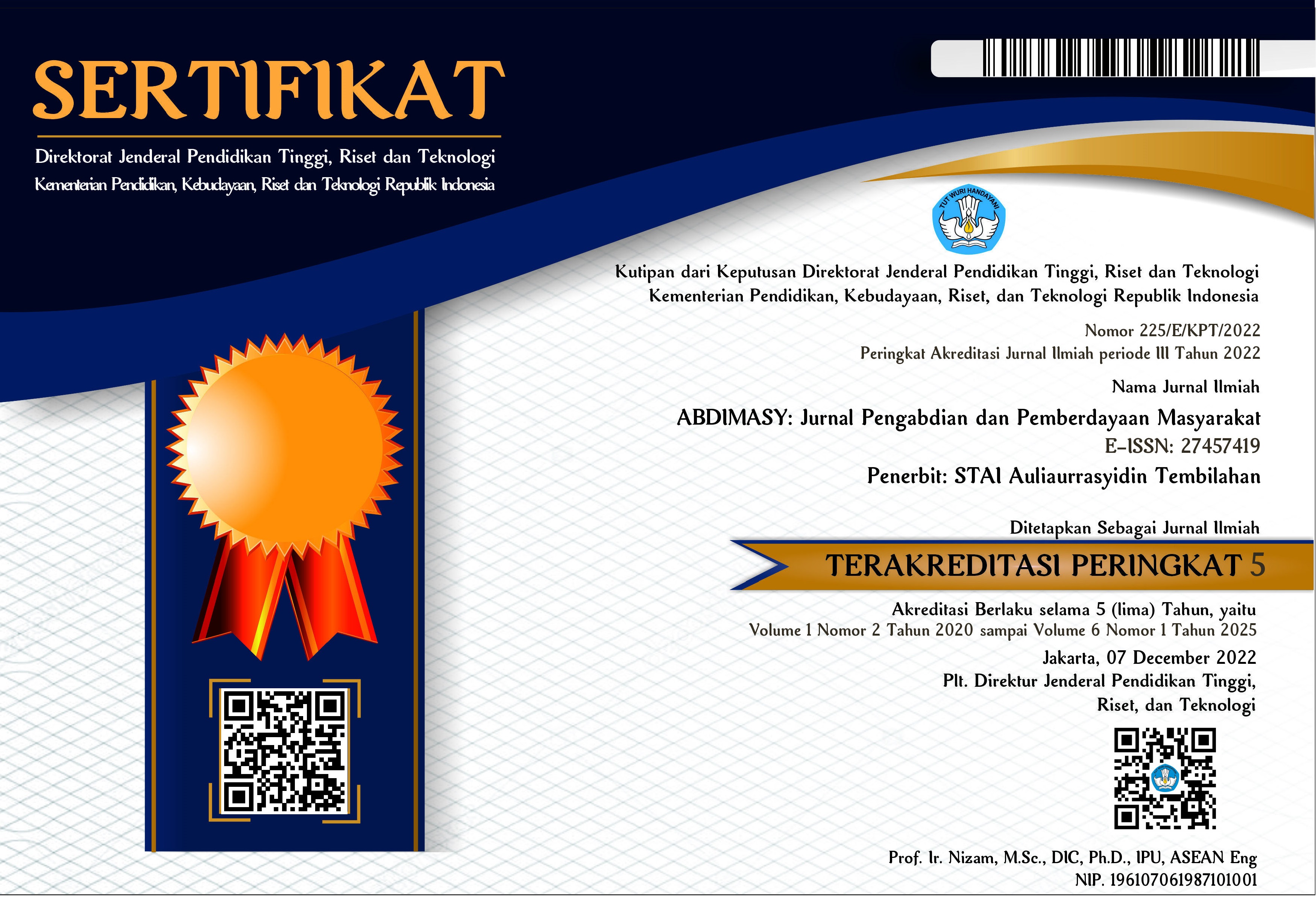Green Economy Community-Led Transformation
Economic Potential via Palm Frond Waste Artisanship in The Halal-Tourism of Eastern Aceh Ecosystem
DOI:
https://doi.org/10.46963/ams.v5i1.1357Keywords:
Palm Frond Waste, Artisanship, Halal-Tourism, Green EconomyAbstract
Palm oil plantations in Eastern Aceh face a challenge: an excess of underutilized palm frond waste, creating environmental and economic burdens. To address this, a study explored empowering local communities to transform this waste into valuable handicrafts, promoting a green economic model. Despite the economic benefits of the palm oil industry, high unemployment persists, especially among the youth in palm-producing areas, with little awareness of the potential in palm frond waste. An apprenticeship program was implemented, providing hands-on training in crafting products like plates, handbags, and prayer mats. This training likely increased participants' confidence and curiosity. By equipping participants with skills before explaining the program’s aim of waste-to-wealth transformation, a strong foundation was laid. The study highlighted participants' enthusiasm and success in producing handicrafts post-training. This community-led approach, focused initially on skill development, shows potential for green economic transformation in Eastern Aceh, reducing waste and creating new income streams, potentially aligning with the region's Halal-tourism sector.
Downloads
References
BPS Aceh. (2021). Luas tanam dan produksi kelapa sawit Aceh tahun 2014-2016. BPS Aceh. https://aceh.bps.go.id/indicator/54/120/1/luas-tanam-dan-produksi-kelapa-sawit.html
Dinas Pertanian dan Perkebunan Aceh. (2020). Laporan tahunan tahun 2020. https://distanbun.acehprov.go.id/media/2021.09/2021_laporan_tahunan_2020_ok1.pdf
Faisal, M., Taleb, M. A., & Nizar, M. (2010). Pemanfaatan tandan kosong kelapa sawit sebagai sumber energi di propinsi aceh dalam skema clean development mechanism. Seminar Nasional Masyarakat Perkelapa Sawitan Indonesia (MAKSI 2010). https://www.researchgate.net/publication/280721865
Fuadi, A., Faridah, F., & Yuniati, Y. (2016). Pemanfatan tandan kosong kelapa sawit sebagai media pertumbuhan jamur merang. Jurnal Pengabdian Kepada Masyarakat (JPKM), 22(4). 16-19. https://doi.org/10.24114/jpkm.v22i4.5756
Garasih, R. L. (2020). Pemanfaatan limbah lidi sawit menjadi produk bernilai ekonomis. Jurnal Pengabdian Masyarakat Multidisiplin, 3(2), 96–102. https://doi.org/10.36341/jpm.v3i2.1075
Haryanti, A., Norsamsi, N., Fanny Sholiha, P. S., & Putri, N. P. (2014). Pemanfaatan limbah padat kelapa sawit. Konversi, 3(2), 20. https://doi.org/10.20527/k.v3i2.161
Irwan, M, Rosdiana, dan Fauzi. K. (2020). Pendampingan Ibu Rumah Tangga (IRT) Dalam Inovasi Produk Limbah Lidi Kelapa Sawit Sebagai Penghasil Tambahan Pada Masa Pandemi Covid 19. Jurnal Education for All, Volume 9 No. 2, 2732. https://jurnal.unimed.ac.id/2012/index.php/efa/article/view/21916. Diakses 27 Juni 2021/ 13.05
Kiki, U. dkk. (2018). Nilai Ekonomi Tanaman Kelapa Sawit (Elaeis guinensis jack) Untuk Rakyat Indonesia. MPRA (Munich Personal RePEc Archieve), 132. https://ideas.repec.org/p/pra/mprapa/90215.html. Diakses 23 Juli 2021/16:20.
Rosadi, D. (2022, January 29). Produksi kelapa sawit rakyat Aceh hanya 2,1 ton per hektar, jauh di bawah perusahaan. Serambinews. https://aceh.tribunnews.com/2022/01/29/produksi-kelapa-sawit-rakyat-aceh-hanya-21-ton-per-hektar-jauh-di-bawah-perusahaan
Soehardi, F., Putri, L. D., & Dinata, M. (2021). NVivo Software Training for Young Researchers. Mattawang: Jurnal Pengabdian Masyarakat, 2(1), 8–13. https://doi.org/10.35877/454ri.mattawang265
Suwardi, A. B, Baihaqi, Fazrina S. (2018). Inovasi Produk Kerajinan Limbah Kelapa Sawit Menggunakan Teknologi Ramah Lingkungan. Jurnal Ilmiah Pengabdian Masyarakat, Volume 4, 18. Agrokreatif https://journal.ipb.ac.id/index.php/j-agrokreatif/article/download/22413/14874.
Downloads
Published
Issue
Section
License
Copyright (c) 2024 Anis Kurlillah, Nurjanah Nurjanah, Munadiati Munadiati, Abdul Hamid, Mauloeddin Afna

This work is licensed under a Creative Commons Attribution-ShareAlike 4.0 International License.
Authors who publish with this journal agree to the following terms:
1. Copyright on any article is retained by the author(s).
2. The author grants the journal, right of first publication with the work simultaneously licensed under a Creative Commons Attribution shareAlike 4.0 International License that allows others to share the work with an acknowledgment of the work’s authorship and initial publication in this journal.
3. Authors are able to enter into separate, additional contractual arrangements for the non-exclusive distribution of the journal’s published version of the work (e.g., post it to an institutional repository or publish it in a book), with an acknowledgment of its initial publication in this journal.
4. Authors are permitted and encouraged to post their work online (e.g., in institutional repositories or on their website) prior to and during the submission process, as it can lead to productive exchanges, as well as earlier and greater citation of published work.
5. The article and any associated published material is distributed under the Creative Commons Attribution-ShareAlike 4.0 International License





2.png)



